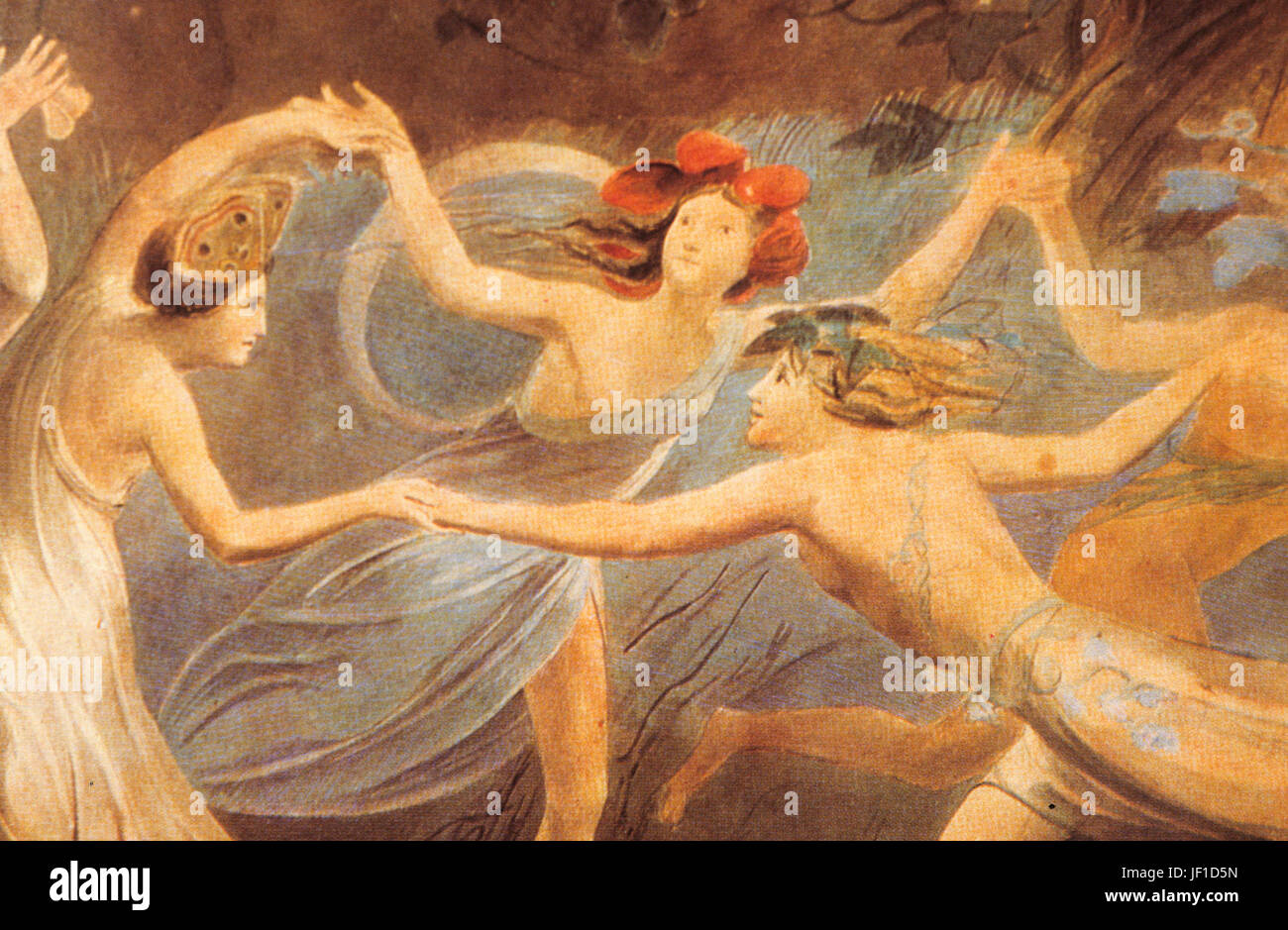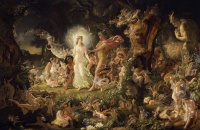- William Blake Oberon Titania And Puck With Fairies Dancing 1786
- What Does Puck Tell Oberon About Titania
Feb 17, 2016 - Artwork page for ‘Oberon, Titania and Puck with Fairies Dancing’, William Blake, c.1786 on display at Tate Britain. At the end of A Midsummer Night’s Dream, fairy king Oberon and queen Titania make friends again, and Moth, Peaseblossom, Cobweb and Mustardseed dance in a ring, while Puck claps the beat.William Blake’s fairies dance on weightless tiptoes wearing petals, leaves and gauzy. Oberon, Titania and Puck with Fairies Dancing. By William Blake, c. In the early 17th century, Shakespeare wrote the so-called 'problem plays' Measure for Measure, Troilus and Cressida, and All's Well That Ends Well and a number of his best known tragedies.
In Shakespeare’s time, fairy tales and the myths of magic were a major part of the culture and the stories were a main source of entertainment for the people of England. Elizabethans spent their unoccupied hours, in the cold, sat around a fire and this is where the story-telling flourished. Shakespeare himself probably grew up listening to these tradition tales and drew from these oral, folk and fairy tales.
Fairy tales were essential in the harsh times that Elizabethans lived in, one full of disease, poverty and death, because it provided emotional support and joy for story-tellers and listeners alike. In the article, “Behind the Happily-Ever-After: Shakespeare’s Use of Fairy Tales and All’s Well That Ends Well” by Ciara Rawnsley, she dives into the purpose and meaning of Fairy Tales at this time in history. Rawnsley references Bruno Bettelheim when addressing the emotional importance of these stories where he says, “For those who immerse themselves in what the fairy tale has to communicate it becomes a deep quiet pool which at first seems to reflect only our own image, but behind it we soon discover the inner turmoils of our soul- its death, and ways to gain peace within ourselves and with the world, which is the reward of our struggles” (144). These fairy tales were a way for people to cope with their own struggles and they were able to learn from them and use that information to self-reflect on their own desires and fears.

However, Fairy tales, upon the basis of its name, are false stories. Rawnsley writes, “Fairy tales, by definition, contain a strong make-believe content: they recount fantasies and wishes, not truth”(144). Many view these tales as escapist fantasies and roll their eyes at the “happily-ever-after” endings. However, looking deeper into the character’s journey, there are dark and primal desires and themes that are hidden not so below the surface, things that are very adult in nature. The anxieties that are delved into and explored are very real and not associated with the make-believe of fairy tales because we as adults can all recognize those emotions within ourselves.

In addition, fairy tales act as a form of wish fulfillment, allowing us an outlet to explore our desires and dreams. In this way, there is an escapist element because you are able to put away reality for a while and immerse yourself in the fantasy where anything is possible. Fairy tales also provide a secure place to confront our subconscious and conscious fears, insecurities, anxieties and such. The characters in the stories are externalizing the emotional struggles that one may be feeling, providing the space for one’s issues to be hashed out and then cleanly put away after the story ends. Rawnsley writes that, “Fairy tales contain certain recurrent emotional situations: jealousy; hate; fear of death, rejection and abandonment; anxiety over sex, courtship and marriage; the desire to prove oneself, be recognised, be loved and so on”(145). All of these elements are a part of the human psyche and fairy tales act as form of releasing these deep-rooted feelings. Not only are the emotions revealed, but through these tales we are able to see the primitive nature of humans and our deep desires. Scholars and psychologists have recognized in the content of fairy tales, “just how violent, sexual, and potent their basic emotional subtexts are” (145). Take Little Red Riding Hood for example, it can be viewed as a cautionary tale for children to listen to their parents but actual substance of the tale is darker in the adult’s perspective compared to the child’s. The story represents one of a young girl being curious of her sexuality and thus being seduced by a predator (wolf/man).

While The Winter’s Tale may not have as many elements of fairy tales compared to other Shakespeare plays, the themes and magical aspects within the play dealing directly with the characters. The ignorance and jealousy of King Leontes is a basic element of fairy tales, his insecurities are laid out for the audience to see and is covered by his anger and denial. In the transition from the first part of the play into the later section, Shakespeare personifies Time, it is given lines and is a being rather than a concept. This contributes to the magical theme of the play, in which reason and reality are absent. One of the most fairy tale-like events of the entire play is when Hermione is brought to life from a statue. There is magic enacted by Paulina accompanied by music and Leontes’ Queen transformed from her inanimate state into her living, breathing form. Leontes, who refused to believe anyone that his daughter was indeed his and that his wife did not commit adultery, at the end of the play has to, ignore reason and let himself believe in the magic Paulina possesses. Paulina tells Leontes, “It is requir’d / You do awake your faith” (5.3. 94-95) and as he trusts Paulina and takes the leap of faith, he is rewarded as he is reunited with his Queen.
Works Cited
Rawnsley, Ciara. “Behind the Happily-Ever-After: Shakespeare’s Use of Fairy Tales and All’s Well That Ends Well.” Journal of Early Modern Studies, 2013, http://www.fupress.net/index.php/bsfm-jems/article/view/12632
In Shakespeare’s time, fairy tales and the myths of magic were a major part of the culture and the stories were a main source of entertainment for the people of England. Elizabethans spent their unoccupied hours, in the cold, sat around a fire and this is where the story-telling flourished. Shakespeare himself probably grew up listening to these tradition tales and drew from these oral, folk and fairy tales.
William Blake Oberon Titania And Puck With Fairies Dancing 1786
Fairy tales were essential in the harsh times that Elizabethans lived in, one full of disease, poverty and death, because it provided emotional support and joy for story-tellers and listeners alike. In the article, “Behind the Happily-Ever-After: Shakespeare’s Use of Fairy Tales and All’s Well That Ends Well” by Ciara Rawnsley, she dives into the purpose and meaning of Fairy Tales at this time in history. Rawnsley references Bruno Bettelheim when addressing the emotional importance of these stories where he says, “For those who immerse themselves in what the fairy tale has to communicate it becomes a deep quiet pool which at first seems to reflect only our own image, but behind it we soon discover the inner turmoils of our soul- its death, and ways to gain peace within ourselves and with the world, which is the reward of our struggles” (144). These fairy tales were a way for people to cope with their own struggles and they were able to learn from them and use that information to self-reflect on their own desires and fears.

However, Fairy tales, upon the basis of its name, are false stories. Rawnsley writes, “Fairy tales, by definition, contain a strong make-believe content: they recount fantasies and wishes, not truth”(144). Many view these tales as escapist fantasies and roll their eyes at the “happily-ever-after” endings. However, looking deeper into the character’s journey, there are dark and primal desires and themes that are hidden not so below the surface, things that are very adult in nature. The anxieties that are delved into and explored are very real and not associated with the make-believe of fairy tales because we as adults can all recognize those emotions within ourselves.
What Does Puck Tell Oberon About Titania

In addition, fairy tales act as a form of wish fulfillment, allowing us an outlet to explore our desires and dreams. In this way, there is an escapist element because you are able to put away reality for a while and immerse yourself in the fantasy where anything is possible. Fairy tales also provide a secure place to confront our subconscious and conscious fears, insecurities, anxieties and such. The characters in the stories are externalizing the emotional struggles that one may be feeling, providing the space for one’s issues to be hashed out and then cleanly put away after the story ends. Rawnsley writes that, “Fairy tales contain certain recurrent emotional situations: jealousy; hate; fear of death, rejection and abandonment; anxiety over sex, courtship and marriage; the desire to prove oneself, be recognised, be loved and so on”(145). All of these elements are a part of the human psyche and fairy tales act as form of releasing these deep-rooted feelings. Not only are the emotions revealed, but through these tales we are able to see the primitive nature of humans and our deep desires. Scholars and psychologists have recognized in the content of fairy tales, “just how violent, sexual, and potent their basic emotional subtexts are” (145). Take Little Red Riding Hood for example, it can be viewed as a cautionary tale for children to listen to their parents but actual substance of the tale is darker in the adult’s perspective compared to the child’s. The story represents one of a young girl being curious of her sexuality and thus being seduced by a predator (wolf/man).
While The Winter’s Tale may not have as many elements of fairy tales compared to other Shakespeare plays, the themes and magical aspects within the play dealing directly with the characters. The ignorance and jealousy of King Leontes is a basic element of fairy tales, his insecurities are laid out for the audience to see and is covered by his anger and denial. In the transition from the first part of the play into the later section, Shakespeare personifies Time, it is given lines and is a being rather than a concept. This contributes to the magical theme of the play, in which reason and reality are absent. One of the most fairy tale-like events of the entire play is when Hermione is brought to life from a statue. There is magic enacted by Paulina accompanied by music and Leontes’ Queen transformed from her inanimate state into her living, breathing form. Leontes, who refused to believe anyone that his daughter was indeed his and that his wife did not commit adultery, at the end of the play has to, ignore reason and let himself believe in the magic Paulina possesses. Paulina tells Leontes, “It is requir’d / You do awake your faith” (5.3. 94-95) and as he trusts Paulina and takes the leap of faith, he is rewarded as he is reunited with his Queen.
Works Cited
Rawnsley, Ciara. “Behind the Happily-Ever-After: Shakespeare’s Use of Fairy Tales and All’s Well That Ends Well.” Journal of Early Modern Studies, 2013, http://www.fupress.net/index.php/bsfm-jems/article/view/12632